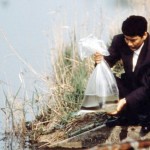Dir. by Shohei Imamura
Images: Conforms, generally speaking, to standard Hollywood continuity editing. Rare exceptions include the brutal murder scene at the beginning of the film, when blood appears to splatter on the lens. Also, subjective dream sequences are borderline expressionistic, though no more unusual than those typically used in the west. Favorite image: Keiko lowering a boxed lunch from a bridge as Yamashita and a friend motor their small fishing boat past her.
• • •
“If my films are messy,” Imamura has said, “this is probably due to the fact that I don’t like too perfect a cinema.” He has also said, “I love all the characters in my films, even the loutish and frivolous ones. I want every one of my shots to express this love.” Strange to find this quote one day after reading a long interview with Wes Anderson, who has said very much the same thing. There’s a strange similarity between The Eel and Anderson’s work—”quirky” is the first (and admittedly meaningless) word that comes to mind.
Before the film’s opening titles we see Takuro Yamashita (played by Koji Yakusho) brutally murder his wife after learning of her affair. Imamura then cuts to Yamashita’s release from prison, where he has served an eight year sentence. Yamashita begins his new life by opening a barber shop a few blocks from his parole officer in a small town inhabited by the quirky (there’s that word again) characters we’ve come to expect from small films like this. There’s the widowed fisherman, the young man who is trying to attract the attention of extra-terrestrials, the nameless hanger-on who wears an air-filter mask while driving his convertible, the troubled woman who imagines herself a flamenco dancer, and the drunken ex-con who torments our hero with reminders of his past. And there’s Keiko, the beautiful woman who Yamashita discovers passed out in a field after she has attempted suicide because she “fell in love with the wrong man.” She comes to work in the barber shop, where, inevitably, the two must reconcile their feelings for each other with the ghosts of their past.
I find it nearly impossible to classify this film. Its murder and sex scenes are more graphic than anything we normally find in mainstream Western films, yet The Eel more often feels like a slightly off-kilter romantic comedy. It maintains a refreshingly slow pace, even while depicting moments of slapstick comedy—the film’s climax, for instance. Like Anderson’s films, The Eel is wonderfully entertaining, perhaps because of the filmmaker’s obvious fondness for his characters and because of the sincere respect he shows them.
